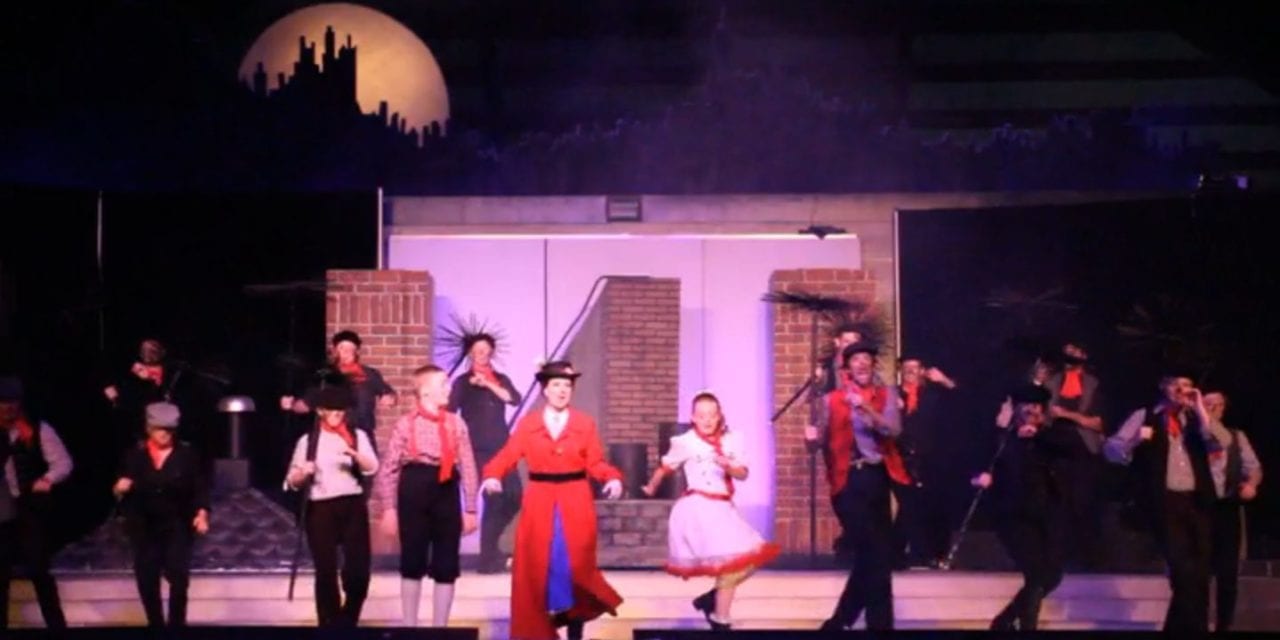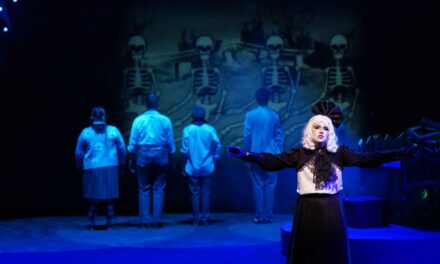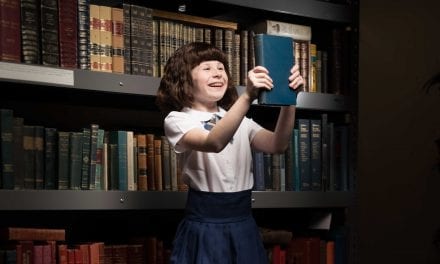HERRIMAN — The road to Herriman feels long and winding, especially if you are coming from anywhere outside of this southwest corner of the Salt Lake Valley, but this little town does summer shows in a big way. Their latest offering is Disney and Cameron Mackintosh’s Mary Poppins, directed by Kristin Housley, and choreographed by Julie Balazs, with music direction by Nicole Thorpe. These women have put together a great family show that continues the tradition of excellent summer theatre offerings from Herriman.

Show closes July 19, 2016.
The first element that stood out to me was the impressive vocal talents of the entire cast. From Mary Poppins (played by Julie Barker), Bert (Stephan Tobian), George Banks (Brent Rindlisbacher) and Winifred Banks (Amy Gwilliam) to the children, Jane (Olivia Hansen) and Michael (Alexander Hill), with a particularly outstanding performance from The Bird Woman (Cassie Jackman), this production boasts stellar vocal chops all around. Every leading cast member was able to do full justice to the music of Robert B. Sherman, Richard M. Sherman, and George Stiles and the lyrics of the Shermans and Anthony Drewe.
Barker’s portrayal of Mary Poppins was delightful, she was stern, mysterious, and fun to watch interact with others onstage. The fact that she is more than “fairly pretty” and had “rosy cheeks” to boot were an added bonus. Barker was a faithful student of Julie Andrews’s iconic film performance, and her hard work would leave very few disappointed. Her beautiful clear soprano never wavered or felt wanting. She was lovely, and well cast in this role. As her faithful friend Bert, Tobian was also a good fit. His lanky loose build and charming singing voice—not to mention impressive dancing skills—brought Dick Van Dyke to mind and was a great foil for Barker’s Mary. His tender flirtation with Mary and her gentle rejection of his overtures kept that relationship intriguing.

“Steppin’ Time”
The Banks Family were sweetly dysfunctional, as they should be in Julian Fellowes‘s script. The children start out bratty, vying for attention, and end up with a greater understanding of where they fit in the family. Winifred struggles to find her niche in a family role she feels ill-suited and under-qualified to fill, and George bridges the generational gap between his parents who left him to the Holy Terror, Miss Andrews (also played by Cassie Jackman, who is reminiscent of Ms. Trunchbull from Matilda, another holy terror) and the father he wants to be. It is clear that George wants to know and love his children personally, but doesn’t know how. The comic relief was provided by the temperamental housekeeper Mrs. Brill (JoAnn Galloway) and accident-prone Robertson Ay (Logan Strasser) who rounded out the household.
 The ensemble was large and well-rehearsed. Some of their best moments can also be attributed, among other things, to their stellar production staff. The Thorpe’s music direction led to a vocal sound that was full and harmonious, with very few problems. Balazs’s choreography was well-done and interesting, ranging from the more simple “Anything Can Happen” to a sweetly pretty “Jolly Holiday” to a brightly bouncing and challenging “Supercalifragilisticexpialidocious.” Bert led the chimney sweeps in a show-stopping “Step in Time,” a number for which the only disappointment was the footlights that obscured the feet of the tap-dancers. “Let’s Go Fly a Kite” was also noteworthy due to the beautiful stage pictures created by the brightly colored kites that filled the stage and spilled into the aisles.
The ensemble was large and well-rehearsed. Some of their best moments can also be attributed, among other things, to their stellar production staff. The Thorpe’s music direction led to a vocal sound that was full and harmonious, with very few problems. Balazs’s choreography was well-done and interesting, ranging from the more simple “Anything Can Happen” to a sweetly pretty “Jolly Holiday” to a brightly bouncing and challenging “Supercalifragilisticexpialidocious.” Bert led the chimney sweeps in a show-stopping “Step in Time,” a number for which the only disappointment was the footlights that obscured the feet of the tap-dancers. “Let’s Go Fly a Kite” was also noteworthy due to the beautiful stage pictures created by the brightly colored kites that filled the stage and spilled into the aisles.
Costumer Emily Berbert had her hands full with the large cast as well as meeting audience expectations of what the main characters should look like and wear. Yet, she and her costume crew did an admirable job. Anyone who has seen the Disney movie expects Mary to wear a blue suit and a hat with cherries when she arrives, and a white dress with red accents during Jolly Holiday, and a red coat during Step in Time. Any attempts to change those iconic images could be met with confusion or disappointment. Mary’s costumes were indeed picture perfect, as were Bert’s busker/sweep/street artist attire, and the striped coat he dons to compliment Mary in Jolly Holiday. A little less perfect were Mrs. Banks costumes, and the assortment of overcoats on the children and various ensemble members that seemed ill-fitting and less historically accurate. But these are small details. For the most part, the costuming was well done, easily recognizable, and very attractive.
Set designer Jolyn Chelak also met the challenges of her job well. The outdoor pavilion where the show was performed is a multipurpose structure in a city park. As a stage, especially for a show that is as technically demanding as this one, there were some obstacles which were very creatively overcome. The cement performing space had no wing space, and hence had no space to store much scenery. The solution was to build a series of columns which could be turned or opened out into walls to create a number of locations: the street in front of the Banks house, the front parlor, or the children’s nursery. When closed, the columns represented the park, the bank, and Bert’s chalk drawing. I was impressed at how many ways the set pieces could be utilized in this clever way. The only downside was that scene changes tended to be a little lengthy, and often the lights would come up for the next scene and catch the stage crew on stage. Also the black masking curtain which was hung at the back of the performance space was often open, allowing the audience to see the people backstage waiting for their entrance, which detracted from the show.
Herriman Arts Council is fortunate to have a live orchestra to accompany the production, a luxury these days. The musicians, under the direction of Meagan Thorup, did a masterful job, were well-balanced and added much to the live theatre experience. Also impressive were flight director Bill Black and co-flight engineer Paul Keel also did a terrific job bringing Mary through the air smoothly and memorably. Again, an especially difficult feat given the limitations of the pavilion performance space. Altogether it was a well-done, well-rehearsed, well-funded production with lots of talent both onstage and behind the scenes.
Lastly, I would be remiss if I did not mention the masterful use of magic in this production. The many theatre tricks that were used to create the magic of Mary Poppins were impressive. As magic consultant, Milo Theron Christensen did a wonderful job. Mary’s famous carpet bag was the least of the stunts. The kitchen that repaired itself, characters vanished, beds appeared from nowhere, and cakes decorated themselves. All these tricks were clearly well-rehearsed and smoothly executed. Even though I understood the workings of the magic (I promised not to tell!) I was still impressed with how fluidly it all came together.
My few teensy complaints would be that the volume of the sound (orchestra and body mics) was overpowering, that the folding chairs were supremely uncomfortable, and that the sight lines were frustrating for my shorter companions. (With a flat stage and an unraked seating area, heads obscure the view anywhere beyond the first few rows.) But beyond these few negatives, Herriman City has produced a great show that will please audiences of all ages.





